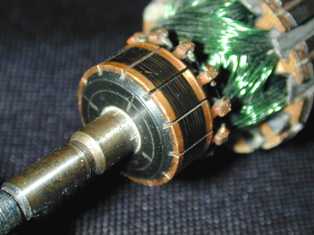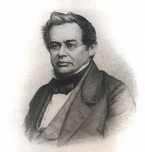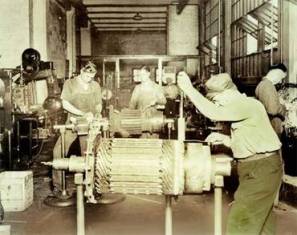Start research processes in electrical machines
In the initial period of the construction of dynamo-electric generators it has been known e. d. s. induction is proportional to the rate of change of the magnetic flux penetrating the loop current, therefore increasing e. d. s. in cars trying to achieve by increasing the speed of the armature.
Careful measurements have shown that the current is given by the generator, at a constant load resistance first increases almost strictly proportional to the speed of the machine, and then the linear dependence of more and more visibly disturbed. This unexpected circumstance tried to explain that with the rapid change in the magnetic field of magnetized steel does not have time (Hypothesis B. Weber).

In 1845, the study of this question engaged X. E. Lentz. Studies carried out with the machine Shterera, led him in 1847 to the extremely important for the development of electric cars conclusions. He showed that the load current flowing through the armature winding creates magnetic flux, which interacts with the main magnetic flux. As a result, the main magnetic flux is weakened, and the neutral line of the machine shifts to the armature rotation.
 Thus, Lenz rightly described the phenomenon that later became known as the armature reaction. It should be noted that by the ideas of the armature reaction came a year before BS Jacobi, but the study of this phenomenon, he was not engaged.
Thus, Lenz rightly described the phenomenon that later became known as the armature reaction. It should be noted that by the ideas of the armature reaction came a year before BS Jacobi, but the study of this phenomenon, he was not engaged.
An important practical result of the study was Lenz reactions armature brushes his proposal to shift in the direction of rotation so that they have been installed on the real neutral line. In modern parlance, Lenz first proposed shift brush with geometric neutral to physical. In the car, "Alliance" has already been used this sentence: current collecting rollers (brush), moving under the action of the rod extending from the centrifugal regulator, which in turn was linked to the machine shaft.
 In 1840 BS Jacobi had made one of the first papers on the theory of electrical machines, the basic content of which is to clarify the nature of the energy processes. In the same paper described the discovery of the Jacobi phenomenon feedback e. d. s.
In 1840 BS Jacobi had made one of the first papers on the theory of electrical machines, the basic content of which is to clarify the nature of the energy processes. In the same paper described the discovery of the Jacobi phenomenon feedback e. d. s.
A significant contribution to the development of electric cars has been the study Zinstedenom cores anchors, on the basis of which he concluded that the feasibility of replacing the massive rod bundles of thin steel wire. This progressive proposal aimed at reducing the eddy current loss, while in electrical engineering practice has not caught on, and before the 70-ies continued to build machines with massive cores.
The first mathematical analysis of the machine is a self-made J. K. Maxwell. In a paper published in 1867, Maxwell, among other things, for the first time introduced the concept of the time constant in the circuit of the electric machine.
Extremely important for the development of electrical engineering were investigating the properties of soft iron and the development of magnetic circuit calculation methods.
Fundamental studies on the magnetization of soft iron, belong to the professor of the Moscow University AG Stoletov. In 1871, the Moscow Mathematical Society AG Stoletov reported on the work will be the subject of his doctoral thesis, in which the dependence of the susceptibility ratio of iron magnetization (the Stoletov factor called the "function of the magnetization") has been deeply investigated.
After spending a lot of very fine experiments with magnetization of the closed iron ring. Stoletov found that susceptibility factor with increasing the magnetization increases, reaches a maximum and then decreases. The research method developed by Stoletov, as the basis of modern methods of studying the magnetic properties of steel.
The practical significance of their research correctly assessed the AG Stoletov, indicating that knowledge of the properties of the iron when it is magnetized equally important for electrical engineering, as knowledge of the properties of steam for the construction of steam engines. Timeliness appearance Stoletova labor becomes obvious if we remember that this work was published in 1871, t. E. After only one year after the construction of the first machines Gramm.
The study of the magnetic properties of iron was continued by many scholars in the 70-80-ies. So, in 1880, E. Warburg discovered the phenomenon of hysteresis losses and .issledovaniya began in iron in demagnetization (T. Ewing, Charles P. Steinmetz).

Of great importance for the design of electrical machines and apparatuses were unemployed J.. Gopktnsona, who in the early 80s has formulated the so-called Ohm's law for the magnetic circuit.
Hopkinson first suggested in the calculation of the electric machine or electromagnetic device to break their magnetic circuit into a number of sections, each of which has a constant magnetic permeability and the cross section and provided Ohm's law for the magnetic circuit.
On the basis of work Hopkinson method was developed for the calculation of the magnetic circuit, which is fully retained their value to this day.
On the basis of theoretical studies carried out in the 70s, it was possible to move from the rough empiricism to a meaningful, sufficiently rigorous design of electrical machinery, apparatus and appliances. First of all, this has resulted in the improvement of the forms of magnetic and therefore to reduce the magnetic scattering and reducing losses. DC machine, in particular to 1890, she received a configuration of the magnetic circuit, which is different from the present.
Belkind LD Veselovsky O. et al. History of energy technology

Comments
Commenting, keep in mind that the content and the tone of your messages can hurt the feelings of real people, show respect and tolerance to his interlocutors, even if you do not share their opinion, your behavior in terms of freedom of speech and anonymity offered by the Internet, is changing not only virtual, but real world. All comments are hidden from the index, spam control.